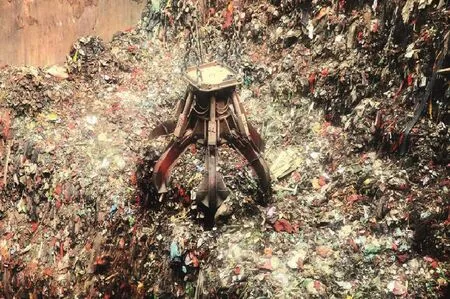TO BURN OR NOT TO BURN
BY LIU SHA (刘莎)
TO BURN OR NOT TO BURN
BY LIU SHA (刘莎)
Incinerators may be the answer to China’s trash problems but itwill take some convincing
不当的垃圾焚烧会对环境和居民健康产生严重影响,烧还是不烧,这是一个问题

While most government-led projects in China manage to succeed, often through sheer force of will, incinerations have become an exception. Compared to the alternatives, most remain skeptical of waste incineration, fearing toxic gases and pollution; the controversy has sparked not-in-my-backyard protests in over 40 cities throughout China.
None of the protesters would deny the importance of preventing garbage from besieging cities and towns, which would only result in more pollution, yet the fear of foul smells and allegedly toxic and even cancer-causing emissions has driven them to the streets and stopped many planned incinerators. In Luoding, a county in southern China’s Guangdong Province, local officials in April agreed to scrap a wastedisposal project after over a thousand villagers took to the streets and some reportedly clashed with police, though no injuries were reported.
The incineration project was planned a year ago and was in line with national policy, the government explained. According to a Ministry of Environmental Protection report in March, China produced 161 million tons of household garbage and nearly 2.4 billion tons of industrial waste in major cities in 2014. Put simply, China has a rubbish problem and incinerators are an easy fix.
In China, landfill and incineration are the two major ways of disposing of household waste, and due to limited land resources as well as the soil and groundwater pollution caused by a heavy reliance on landfill, the central government started to encourage waste processing a few years ago.
In 2010, over 20 percent of household waste was disposed by incineration and 77 percent by landfill. The State Council set a goal in its 12th five-year plan, which covers the period from 2011 to 2015, saying that in 2015, 35 percent of waste would be dealt with by incineration.
To achieve this goal, as some experts and entrepreneurs predicted, 300 incineration projects would be put into use in 2015, capable of handling 300,000 tons of garbage a day.
Yet, the latest data collected by Anhui-based environmental protection organization, Wuhu Ecology Center, shows 160 incinerators were operating nationwide as of June.
The smaller-than-expected number coincides with the difficulties experienced by incineration plants.
Protesters in Hangzhou, eastern China’s Zhejiang Province, set two police cars on fire and blocked a highway in April 2014. Ten protesters and 29 officers were injured in the clash and the project was postponed. The local Party chief promised that the construction would not start without public support and all due legal process, the Xinhua News Agency reported.
Protester Wang Weimin, a 46 year-old-entrepreneur who grew up in Luoding and now works in Shenzhen, said he knew that incineration projects were not evil in nature, but he couldn’t shake the feeling of dangers posed by profit-hungry operators.
Incineration is a waste treatment process that burns rubbish to ash, heat, and gas. The advantage is that it can reduce rubbish volume by up to 90 percent and the electricity generated during the process can be used. Fly ash, however, contains heavy metals and the carcinogenic chemical dioxin.
In 2014, the Wuhu Ecology Center and Friends of Nature asked 160 plants about how they dealt with fly ash and 39 answered; 26 said they sent it to a landfill, five used it as construction material, and eight sent it to hazardous waste disposal sites.
Sending ash to a landfill is not particularly environmentally damaging if the ash has properly solidified, with contaminants immobilized and heavy metals less leachable.
However, the heavy metals and toxic chemicals still percolate into the soil if the solidified fly ash is mixed with normal wastes or soaked in water, says 72-year-old Zhao Zhangyuan, a researcher at the Chinese Research Academy of Environmental Sciences and a firm opponent of incineration.
Turning the ash into construction material sounds resourceful, but there are as yet no national standards to gauge toxicity. “Even bricks are toxic, there is no way to detect it,” Nie Yongfeng, a professor of environmental science with Tsinghua University, told theSouthern Weeklyin 2013.
Sending fly ash to hazardous waste disposal sites is relatively safer, but according to the China Environmental Statistics Yearbook 2013, there are only 40 qualified enterprises for disposing of hazardous waste in eastern China while there are over 100 incineration plants.
It is difficult to measure the damage caused by fly ash to the environment and human health. An example also often used by opponents is that, in 2010, an incinerator in Macao failed to properly deal with fly ash and 123 out of 522 residents living near the incinerator were found to have lung and respiratory problems. In order to confirm the link between health problems and the ash, the Macao government commissioned the Chinese University of Hong Kong to conduct a 10-year study.
But Liu Yangsheng, a professor at Peking University and a supporter of incineration projects, argues that the technology has matured enough to ensure emissions meet standards—stating that the last major hurdle is public doubt.
Liu cites the Ministry of Housing and Urban-rural Development which inspected nearly half of incinerators nationwide and found 90 percent of them with a dioxin concentration lower than 0.1 nanogram per cubic meter (ng/Nm3), lower than the previous national standard of 1.0 ng/Nm3. “If these plants continue to operate steadily, we don’t have to worry about pollution control,” Liu says.
The national standard of pollutant emissions for incinerators was amended in July 1, 2014, and has been called the “strictest” rule so far. For dioxin concentrations, the 1.0 ng/Nm3 requirement was changed to 0.1, which has been applied by the EU since 2000.
With the amendment, the public will hopefully have more confidence in incinerations. In Hangzhou, after the clash, over 2,400 residents were taken on a visit to waste incinerator projects in Guangzhou and Nanjing to “learn about waste incineration technology”.
Chen Liwen, a researcher with the NGO Nature University, is tired of choosing between landfill and incineration. “Incineration should not be made the only alternative for landfill...We should learn to manage waste rather than simply process it. The producers of garbage should be included in the circle and take the responsibility for reducing waste.”

